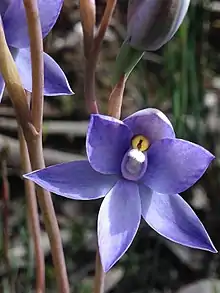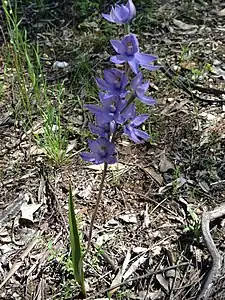| Plains sun orchid | |
|---|---|
 | |
| Thelymitra megacalyptra near Strathfieldsaye | |
| Scientific classification | |
| Kingdom: | Plantae |
| Clade: | Tracheophytes |
| Clade: | Angiosperms |
| Clade: | Monocots |
| Order: | Asparagales |
| Family: | Orchidaceae |
| Subfamily: | Orchidoideae |
| Tribe: | Diurideae |
| Genus: | Thelymitra |
| Species: | T. megacalyptra |
| Binomial name | |
| Thelymitra megacalyptra | |
| Synonyms[1] | |

Thelymitra megacalyptra, known as Thelymitra megcalyptra in Australia,[2] and commonly known as plains sun orchid,[3] is a species of orchid that is endemic to eastern Australia. It has a single erect, fleshy leaf and up to fifteen blue to purplish, sometimes lilac, pink or white flowers with white tufts on top of the anther.
Description
Thelymitra megacalyptra is a tuberous, perennial herb with a single erect, leathery, fleshy, channelled, dark green, linear to lance-shaped leaf 100–350 mm (4–10 in) long and 5–20 mm (0.2–0.8 in) wide with a purplish base. Between two and fifteen blue to purplish, sometimes lilac, pink or white flowers 25–45 mm (1–2 in) wide are arranged on a flowering stem 200–600 mm (8–20 in) tall. There are usually two bracts along the flowering stem. The sepals and petals are 15–22 mm (0.6–0.9 in) long and 5–11 mm (0.2–0.4 in) wide. The column is pale blue, white or pinkish, 6–8 mm (0.2–0.3 in) long and 3–4.5 mm (0.1–0.2 in) wide. The lobe on the top of the anther is dark brown to blackish with a yellow tip and a V-shaped notch. The side lobes turn forwards and have white, toothbrush-like tufts on their ends. The flowers are scented, long-lived, insect-pollinated and open on sunny days. Flowering occurs from August to November.[3][4][5][6]
Taxonomy and naming
The plains sun orchid was first formally described in 1879 by Robert Fitzgerald who gave it the name Thelymitra megcalyptra in his book Australian Orchids.[7][8] The Australian Plant Census[2] and Australian state herbaria retain the name Thelymitra megcalyptra for this species[3][4][5][6] but Plants of the World Online uses Thelymitra megacalyptra.[1] Fitzgerald gave the specific epithet (megcalyptra) in reference to "the large hood of the column, by which it is readily distinguished from T. media".[8]
Distribution and habitat
Thelymitra megacalyptra grows in forest, heath and scrubland, sometimes forming large colonies. It occurs in New South Wales south from the Mount Kaputar National Park, in the Australian Capital Territory, in drier parts of Victoria and in the south-east of South Australia.[3][4][5]
References
- 1 2 3 "Thelymitra megacalyptra". Plants of the World Online. Retrieved 22 June 2023.
- 1 2 "Thelymitra megcalyptra". Australian Plant Census. Retrieved 21 June 2023.
- 1 2 3 4 Jones, David L. (2006). A complete guide to native orchids of Australia including the island territories. Frenchs Forest, N.S.W.: New Holland. p. 231. ISBN 1877069124.
- 1 2 3 Jeanes, Jeff; Stajsic, Val. "Thelymitra megcalyptra". Royal Botanic Gardens Victoria. Retrieved 12 May 2018.
- 1 2 3 Bernhardt, Peter. "Thelymitra megcalyptra". Royal Botanic Garden Sydney. Retrieved 13 May 2018.
- 1 2 Jeanes, Jeffrey A. (2013). "An overview of the Thelymitra nuda (Orchidaceae) complex in Australia including the description of six new species". Muelleria. 31: 27–30. Retrieved 22 June 2023.
- ↑ "Thelymitra megcalyptra". APNI. Retrieved 22 June 2023.
- 1 2 Fitzgerald, Robert D. (1879). Australian Orchids (PDF). Vol. 1. Sydney: Thomas Richards, Government Printer. p. 5. Retrieved 22 June 2023.
External links
 Media related to Thelymitra megacalyptra at Wikimedia Commons
Media related to Thelymitra megacalyptra at Wikimedia Commons